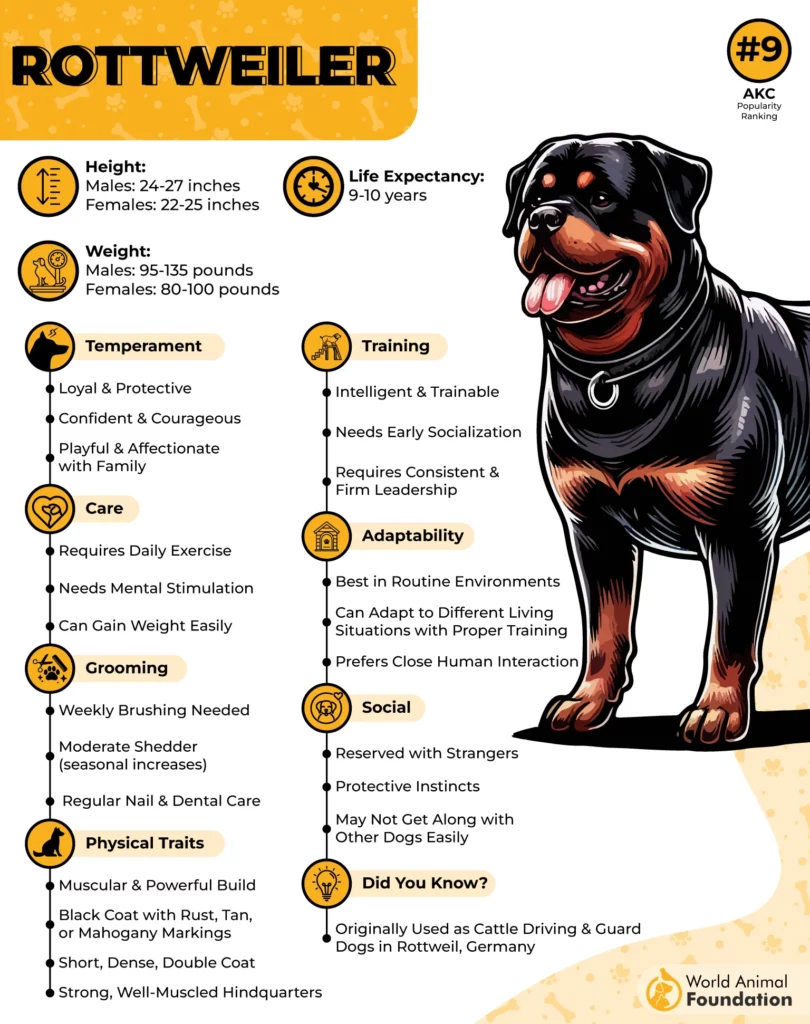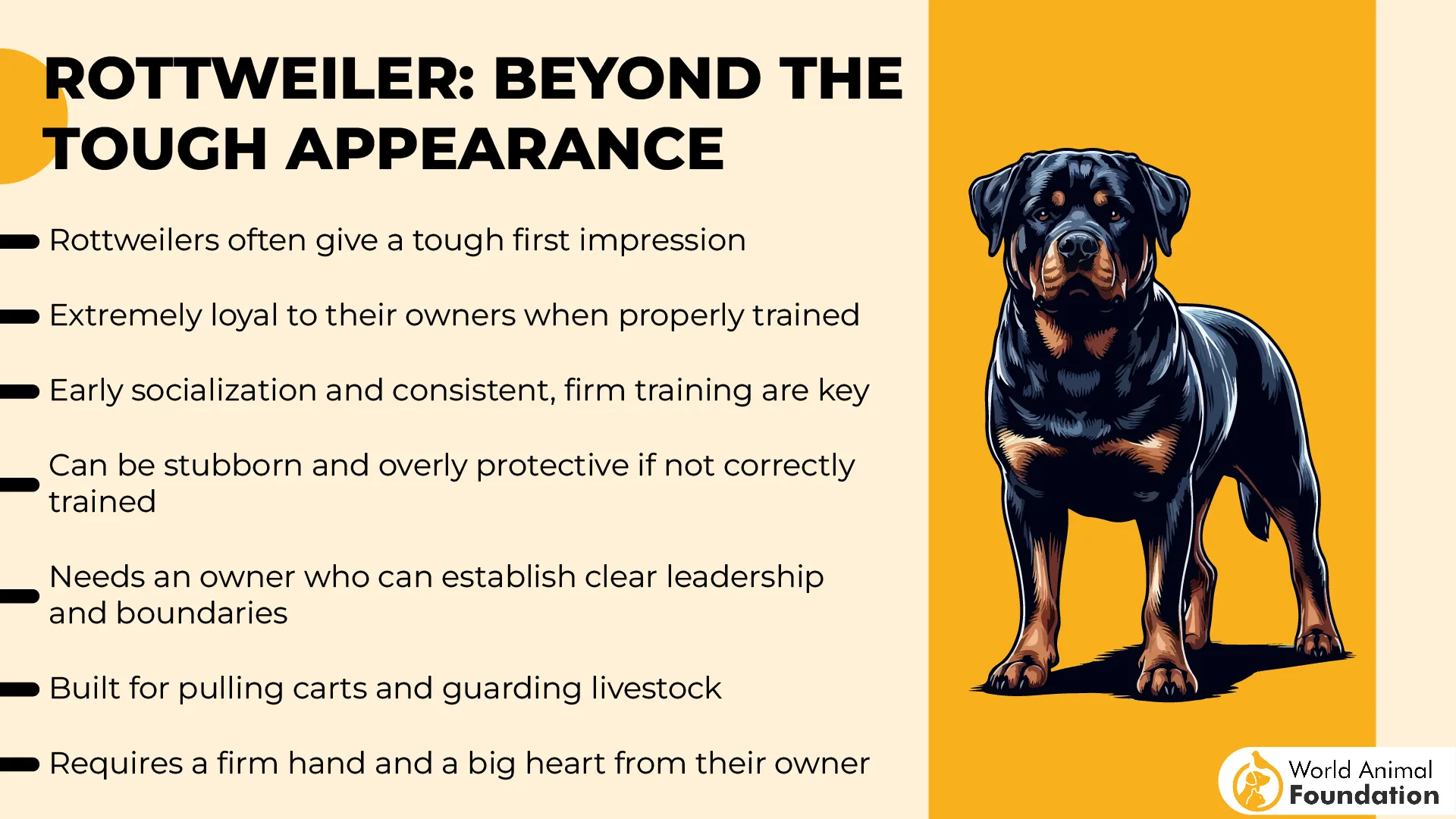You’ve probably seen both of these dogs before. Big, bold, unforgettable. One’s solid and watchful. The other’s warm and almost cartoonishly gentle.
And here you are stuck between the two, wondering which one’s right for you. That’s not a small question. In fact, it’s probably the most important step before bringing a dog home.
Because the truth is, the dog you choose will shape your days. Your pace. Even your peace of mind. So you’re not just choosing a breed, you’re choosing a rhythm to live by. No one wants to end up with regrets, or worse, rehoming.
That’s why taking a few minutes now to slow down and really see what fits is smart. You’ve already done the hard part—admitting you don’t want to guess. Now let’s do the helpful part. Let’s look at what actually matters, without all the noise. You deserve to choose with certainty. Let’s start there.
Rottweiler vs. Saint Bernard
Size and Weight Comparison
Rottweiler dogs are muscular and compact, typically weighing between 80–135 pounds, depending on gender and build. Their height ranges from 22 to 27 inches, giving them a powerful but balanced frame. Their dense structure makes them feel heavier than they appear.

Built for resilience
Saint Bernards tip the scales with ease, averaging between 120–180 pounds, and can reach up to 30 inches in height. Their massive bone structure and wide chests contribute to their overall heft. Moving them requires effort, especially when they’re fully grown.
How space needs differ
A Rottweiler fits comfortably in a moderately sized home with structured activity and space to move. Saint Bernards need significantly more room, not just for activity, but to accommodate their sheer physical footprint. Their weight also puts pressure on floors and joints over time.
Functional weight impact
The average daily strain on their joints is higher in Saint Bernards, which affects their mobility as they age. Rottweilers are more agile, allowing for better control in training or urban environments. Size in both cases isn’t just a number—it’s tied to long-term physical management.
Personality and Temperament Comparison
Rottweiler: Bold, Watchful, and Deeply Devoted
Rottweilers carry a calm intensity and quiet confidence that makes their presence hard to ignore. They form tight-knit bonds with their families and are often seen as incredibly loyal protectors. While they may seem reserved at first, their affection runs deep for those they trust.

Saint Bernard: Gentle Spirit With a Big Heart
Saint Bernards are famously kind, patient, and easygoing — a true definition of a gentle giant, as stated in Britannica. Their sweet nature makes them perfect for homes looking for a soft, calm presence around kids. They respond best in peaceful environments, where the pace of life isn’t rushed or noisy.
Comparing Emotional Depth and Sensitivity
Rottweilers are more emotionally intense and tuned into potential threats or changes in routine, according to the AKC. Saint Bernards are relaxed and slower to react, bringing a quiet warmth into the home. Both can coexist peacefully with cats, though early introductions make all the difference.
Companionship That Grows With Time
Rottweilers crave closeness and often position themselves as shadows to their favorite human. Saint Bernards enjoy companionship too, but with more independence and less need for control. If you’re thinking about the future, both offer decades of unwavering love in different forms.

Energy Levels and Activity Requirements
Naturally active and alert
The Rottweiler has a steady energy level that’s best managed through structured activity. It thrives with purpose, whether through training, guarding, or outdoor tasks. This isn’t a dog that does well without regular outlets for both physical and mental drive.
Moderate but consistent needs
Saint Bernards have lower daily energy compared to a Rott, but still benefit from daily movement, as per PetMD. Short walks and gentle play help prevent boredom and stiffness in their large frames. They’re not lazy—they simply pace themselves and prefer calm over chaos.
Working instinct and mental stimulation
The Rottweiler is not just physically capable but also highly intelligent, requiring more than basic commands to stay engaged, as Petplan claims. Activities like obedience drills or puzzle-based games suit this breed well. It’s the mental challenge that really keeps them balanced.

Space, structure, and balance
Saint Bernards do well in homes with room to stretch but don’t demand high-impact routines. Their temperament is generally calm, but neglecting consistent activity can affect mood and mobility. Both breeds, in their own way, benefit from structured exercise.
Health and Lifespan Comparison
Overall Health Profile
Rottweilers tend to be more muscular and athletic, which supports joint strength and mobility as they age. Saint Bernards, due to their larger build, are more prone to issues like arthritis and cardiac concerns. Their size directly affects the stress on their joints and organs.
Lifespan Range
Rottweilers usually live between 9 to 10 years, slightly above the typical range for giant breeds. Saint Bernards often have a shorter lifespan, averaging 8 to 10 years with good care. Both breeds benefit from early health screenings and regular veterinary follow-ups.

Common Health Concerns
Rottweilers are at higher risk for cancers, particularly bone cancer, which significantly impacts longevity. Saint Bernards commonly face bloat and orthopedic issues, especially in their hind limbs. Preventive measures and awareness of breed-specific risks are essential.
Maintenance for Longevity
Both breeds need carefully balanced diets to avoid unnecessary weight gain that can stress joints and internal systems. Regular moderate exercise and weight control play a key role in managing long-term health. Consistent vet care helps detect and manage age-related conditions early.
Diet and Weight Management
Rottweilers’ balanced intake for active builds
Rottweilers have muscular frames that need a diet rich in protein, moderate in fat, and tailored to their energy levels. Overfeeding can quickly lead to weight gain if not paired with daily activity. Portion control and scheduled feeding are key to maintaining muscle without excess fat.

Watch for joint strain from excess weight
Even a small increase in weight can stress their joints, especially as they age. High-quality food with joint-supporting nutrients like glucosamine can be helpful. Regular weigh-ins and adjusting calorie intake as they mature make a big difference long term.
Saint Bernards’ slower metabolism and higher risk of weight gain
Saint Bernards are more prone to putting on weight, as highlighted by Pet Health Clinic. They require calorie-conscious meals, especially when they’re not highly active. Feeding should be divided into two or more small meals to prevent bloating and manage intake.

Supporting heavy frames with lean nutrition
Due to their size, excess weight can quickly become a health risk. Their diet should include lean proteins, joint-supporting supplements, and limited treats. Consistent feeding schedules and avoiding high-fat extras help manage their large but sensitive bodies.
Grooming Needs and Allergy Potential
Coat type and shedding patterns
Rottweilers have a short double coat that sheds moderately year-round, with noticeable increases in spring and fall. Saint Bernards, on the other hand, have a dense and longer coat that sheds heavily, especially during seasonal changes. Both require routine brushing, but the Saint’s coat needs more attention to manage loose hair.
Brushing frequency and grooming time
A Rottweiler typically needs brushing once or twice a week to keep its coat clean and minimize shedding. Saint Bernards need brushing at least three times weekly to prevent mats and manage the heavy undercoat. Grooming sessions for Saints often take longer due to coat volume and thickness.

Bathing and upkeep differences
Rottweilers generally require less frequent bathing and grooming visits since their coat repels dirt well. Saint Bernards tend to get messier more often, especially around their chest and legs, requiring more frequent cleaning. Their facial folds and ears also need regular checks to avoid buildup or infections.
Allergy considerations for sensitive owners
Neither breed is hypoallergenic, but Saint Bernards tend to trigger allergies more due to excess dander, drooling, and dense coat. Rottweilers, while still shedding, release less dander overall and have fewer grooming-related allergens. For sensitive households, grooming routines can make a noticeable difference.
Bite Force and Jaw Characteristics
Raw pressure and control
Rottweilers have one of the strongest bite forces among domestic dogs, measured at around 328 PSI. Their broad skull and muscular jaws give them precise control during grip. It’s not just strength—it’s how they manage that strength that stands out.
A gentler kind of power
Saint Bernards possess powerful jaws, too, but their bite force, while significant, is not commonly measured for aggression or work. Their head shape supports force, but it’s used more in pulling and holding, not guarding. Their bite lacks the sheer tension seen in working breeds.

Built for different instincts
The Rottweiler’s bite strength evolved from its history as a guard and cattle-driving dog. Every part of its jaw structure is designed to secure, hold, and defend. The Saint Bernard, however, was bred for rescue and endurance, not protection or aggressive engagement.
Structure reveals intent
Rottweilers have a more compact, defined jawline that supports targeted pressure, useful in both herding and guarding roles. Saint Bernards have a broader, softer jaw structure suited for hauling and support tasks. Their build shapes their purpose, not just their look.
Conclusion
No two dog breeds offer the same blend of personality, presence, and purpose, and Rottweilers and Saint Bernards prove that.
If you’ve read this far, take this as your sign to pause. This decision deserves a thoughtful moment, not a quick reaction. Maybe you’ve felt a bit more drawn to strength and structure. Or maybe calmness and kindness are what catch your attention.
Either way, one of these breeds is waiting to add a lasting, loyal layer to your life. Grooming-wise, Rottweilers keep things simple with minimal grooming, while Saint Bernards need a little more care, but both give so much more than they ask for.
Let your lifestyle, not trends, make the final call. And when you welcome your new companion home, it won’t just be a choice—it’ll be a shared experience, one that grows every day. A steady, loyal partner who quietly becomes the best part of your routine.


